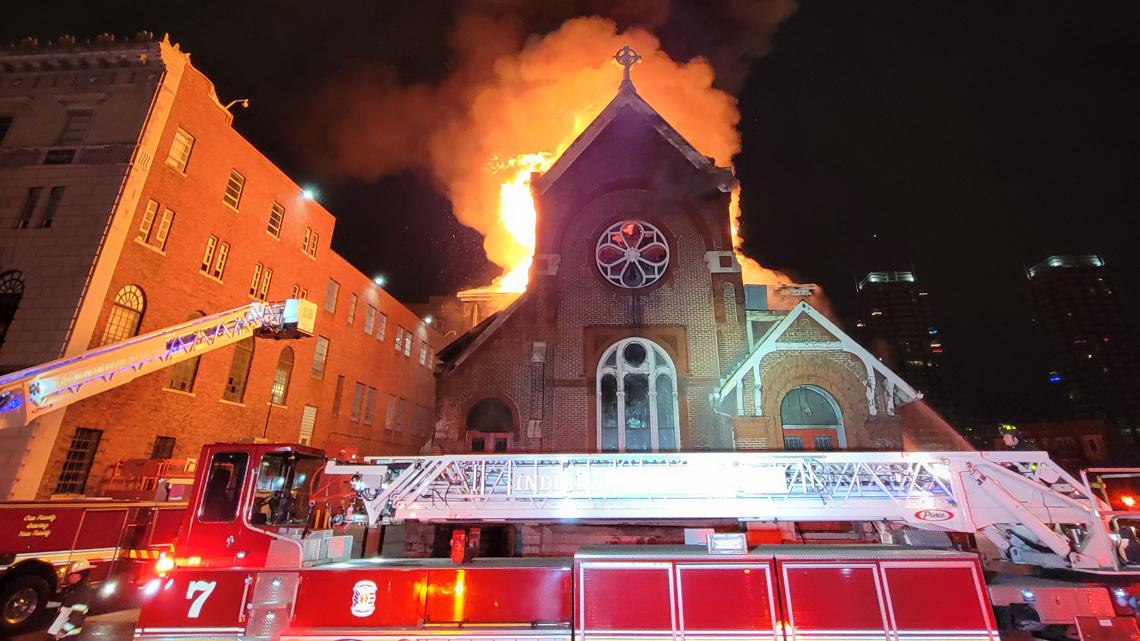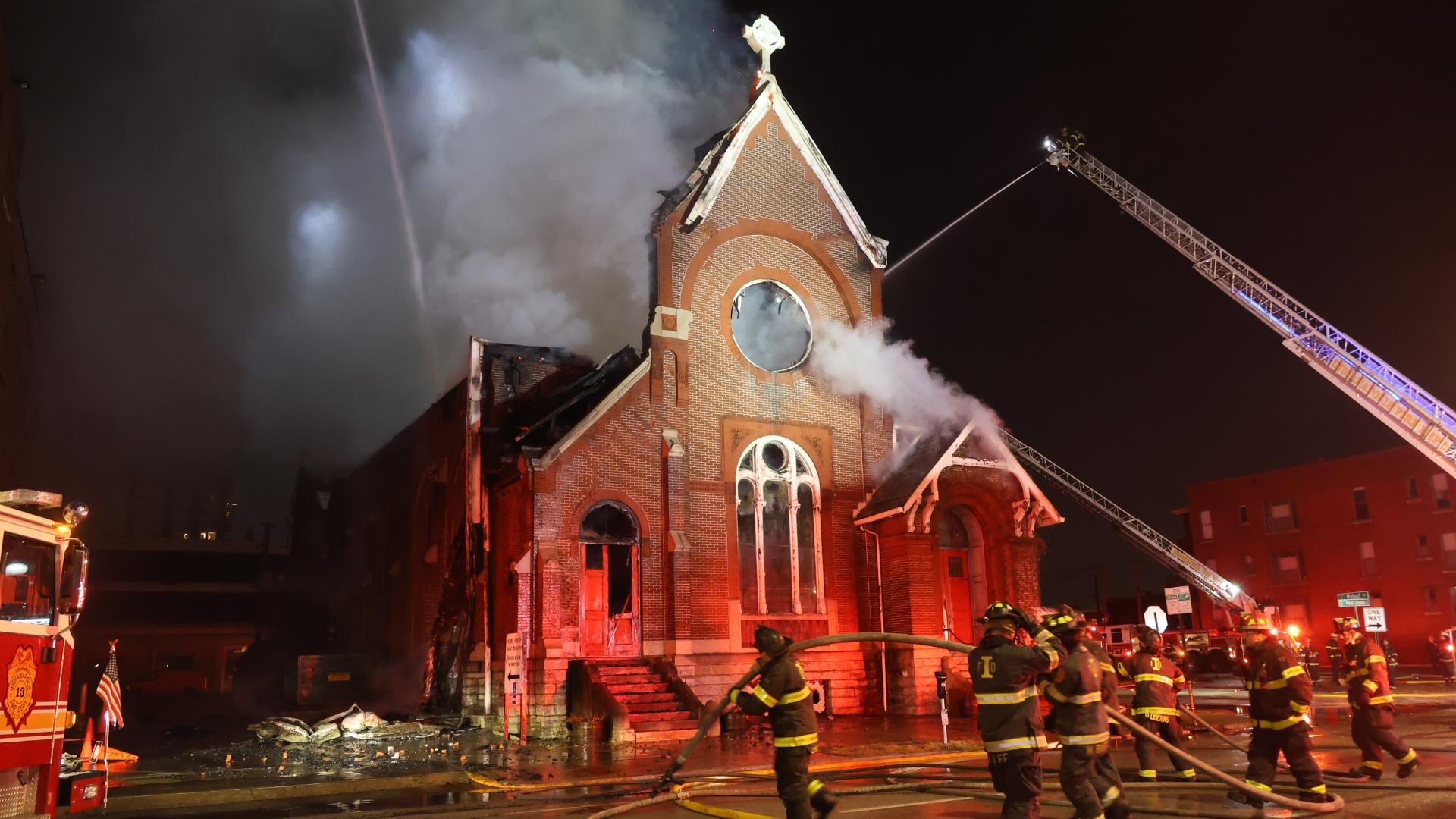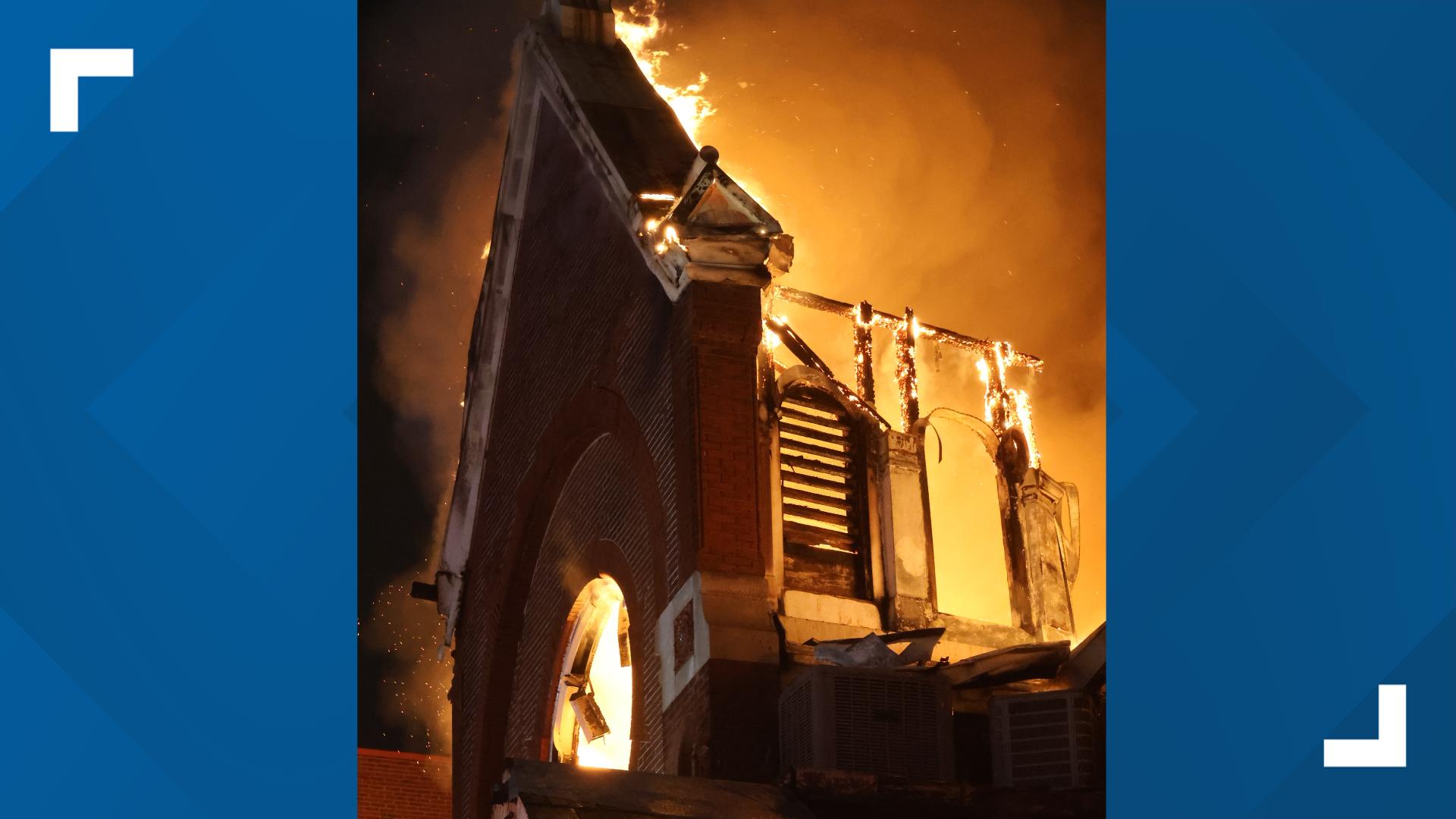When a significant event like a building fire happens, especially in a familiar spot, people naturally want to know what happened. So, the question, "What caused the fire at Sanctuary on Penn?" isn't just about curiosity; it's about understanding, about safety, and in a way, about finding a path forward for the community. This kind of event, you know, it touches many lives and leaves a lasting mark on the area.
It's very natural for folks to seek answers when something big like this occurs. Fires, after all, can be quite devastating, not just to structures but to the spirit of a neighborhood. Knowing the underlying factors that led to such an occurrence helps everyone process the situation and, perhaps, learn how to prevent similar incidents in the future. It's about piecing together the story, bit by bit.
The immediate aftermath of a fire often leaves a lot of questions hanging in the air, and figuring out the precise origin and reason can take a good bit of time and effort. People are often eager for quick answers, but the process of determining what brought about such an event is often a thorough and careful one, involving specialists and a lot of detailed work. It really is a big job to find out what caused something bad.
Table of Contents
- The Sanctuary on Penn Fire: A Community Impact
- The Core Question: What Caused the Fire?
- What Happens Next in the Investigation?
- Lessons Learned: Preventing Future Tragedies
- Frequently Asked Questions About the Sanctuary on Penn Fire
The Sanctuary on Penn Fire: A Community Impact
Fires, particularly those involving larger structures, have a way of capturing the attention of an entire community. The incident at Sanctuary on Penn, like any major fire, isn't just about the damage to bricks and mortar; it also sends ripples through the lives of people who live, work, or simply pass by the area. It can be a very unsettling experience for everyone nearby, that's for sure.
Local businesses might face disruptions, and residents living close by might experience inconveniences or even worry about their own safety. The presence of emergency services, road closures, and the general atmosphere of an ongoing situation can certainly change the daily rhythm of a place. It's a vivid reminder of how quickly things can change, you know, in a city.
Moreover, these events often bring people together, fostering a sense of shared experience and concern. There's often a collective desire to support those affected and to understand how such a thing could have happened. This shared experience can, in a way, strengthen community bonds, even in the face of trouble.
Initial Response and Immediate Aftermath
When a fire breaks out, the immediate response from fire departments and other emergency personnel is always swift and focused. Their primary goal is to contain the blaze, protect lives, and prevent further damage, and they really do move fast. This initial phase is often chaotic, with sirens blaring and crews working tirelessly to get things under control.
After the flames are put out, the scene shifts from active firefighting to securing the area and beginning the preliminary assessment. This is when the first steps toward figuring out what caused the fire are taken, even if it's just a general look around. It's a very critical time for gathering initial observations, you see.
The aftermath can leave a lasting visual impression, with smoke-stained buildings and areas cordoned off for safety. For those who frequent the location, seeing such a familiar place altered can be quite jarring, and it certainly leaves a lot of questions in people's minds. It makes you think, doesn't it?
The Building Itself: What is Sanctuary on Penn?
Understanding the building involved in a fire can sometimes offer clues or context for the investigation. Sanctuary on Penn, for instance, has its own history and characteristics that make it unique. Knowing what kind of structure it is, what it was used for, and perhaps its age, can be a bit helpful for investigators.
Whether it's an older structure with specific construction materials or a newer building with modern systems, these details matter. The purpose of the building – residential, commercial, mixed-use – also plays a role in how a fire might spread or what potential hazards might exist. It really does make a difference, the kind of building it is.
Information about the building's previous uses or any recent renovations might also come into play during the investigation. Every building has a story, and sometimes that story can offer insights into an incident like a fire. It's like putting together pieces of a puzzle, you know.
The Core Question: What Caused the Fire?
The big question on everyone's mind after a fire is, of course, "What caused it?" This isn't a simple query, and finding the answer requires a lot of specialized knowledge and careful examination. It's about understanding the series of events that brought about the destructive outcome, and that's a very particular kind of work.
Fire investigators, often called fire marshals, are the ones tasked with this important job. They look for the origin of the fire, meaning where it started, and then try to figure out the cause. It's a bit like detective work, but with a scientific twist, you could say.
They gather evidence, talk to witnesses, and analyze burn patterns, all to piece together the narrative of how the fire began. This process can be quite extensive, and it takes time to do it right. So, waiting for answers is often part of the deal, unfortunately.
The Intricacies of Fire Investigation
Fire investigation is a detailed and often challenging field that combines science, engineering, and investigative techniques. Investigators are trained to look for subtle clues that might not be obvious to the untrained eye, and they really do pay attention to every little thing. They use their experience to interpret the physical evidence left behind by the flames.
They might examine electrical systems, heating units, appliances, and even the remnants of everyday items that could have played a role. The way materials burn, how smoke travels, and the patterns left on walls and floors all tell a story to an experienced investigator. It's quite fascinating, how much they can learn from the scene.
Sometimes, the scene is so damaged that finding clear evidence becomes even more difficult, which is why these investigations can stretch on for weeks or even months. It requires patience and a very methodical approach to get to the bottom of things. You know, it's not always a quick answer.
Common Causes of Commercial Building Fires
While every fire is unique, there are some common culprits behind commercial building blazes that investigators often consider. Electrical issues, for example, are a frequent cause, stemming from faulty wiring, overloaded circuits, or old equipment. It's a pretty common thing, electrical problems.
Heating equipment malfunctions, such as issues with furnaces or boilers, can also spark fires. Cooking equipment, especially in restaurants or buildings with commercial kitchens, is another significant source of fires. These are areas where, you know, a lot of heat is generated.
Other potential causes include arson, careless smoking, or even spontaneous combustion of certain materials. Sometimes, human error or negligence plays a role, like leaving flammable materials too close to a heat source. So, it's not always just one thing, you see.
The Role of "Cause" in Investigations
The very word "cause" is central to these investigations, meaning what exactly brought about the fire. As we've discussed, what *caused* refers to the action or event that results in the occurrence or existence of something. It implies there's a direct or indirect relationship between the cause and its effect, indicating how one thing led to another. Finding out what *caused* something bad, like a fire, is a big job, after all.
Investigators are trying to pinpoint the agent or condition that permitted the occurrence of the fire or led to its result. This isn't just about identifying the first spark, but understanding the chain of events that allowed that spark to grow into a destructive blaze. It's about finding what produced the fire, in a way.
So, when we ask "What caused the fire at Sanctuary on Penn?", we're asking for that specific element or combination of elements that initiated the event. It's about figuring out what created, brought, or prompted the fire, which is the whole point of the investigation, really.
What Happens Next in the Investigation?
Once the immediate danger has passed and the fire is out, the investigation shifts into a more systematic phase. This period is often characterized by careful evidence collection and analysis, and it can take a good bit of time. People often wonder why it takes so long, but there's a lot to do.
The site will remain secured, sometimes for an extended period, to protect the integrity of the scene. This allows investigators to work without interruption and to ensure no evidence is disturbed. It's a very important step in the whole process, you know.
During this time, official updates might be limited as investigators piece together their findings. It's a quiet but crucial period where the real work of determining the fire's origin and cause unfolds. Everyone is waiting for the official word, naturally.
The Process of Determining Origin and Cause
The process of determining origin and cause is a methodical one, often following established protocols and scientific principles. Fire investigators typically begin by examining the least damaged areas and working their way towards the most heavily burned sections, which helps them trace the fire's path. It's a bit like following a trail, you could say.
They look for specific patterns on surfaces, charring depths, and the presence of any accelerants or unusual materials. Samples might be collected for laboratory analysis, which can reveal the presence of ignitable liquids or other substances. This kind of testing is very precise, and it takes time.
Witness statements, surveillance footage, and even weather conditions at the time of the fire are all factored into the investigation. All these pieces of information help to build a comprehensive picture of what happened. It's like putting together a very complex puzzle, that's for sure.
Waiting for Official Findings
The public often has to wait patiently for the official findings of a fire investigation. Fire departments and other authorities usually don't release information until their investigation is complete and verified. This is to ensure accuracy and to avoid speculation, which is very important.
Premature announcements could lead to misinformation or even interfere with potential legal proceedings if foul play is suspected. So, while the wait can be frustrating for those seeking answers, it's a necessary part of a thorough and responsible investigation. It really is about getting it right, you know.
Once the investigation is concluded, the findings are typically released through official channels, such as press conferences or public reports. This is when the community finally gets the answers they've been waiting for regarding what caused the fire. It's the moment everyone has been anticipating, in a way.
Lessons Learned: Preventing Future Tragedies
While the focus is often on what caused a specific fire, these events also serve as powerful reminders about the importance of fire safety in general. Learning from incidents like the one at Sanctuary on Penn can help prevent similar tragedies in the future. It's about taking what we learn and putting it into practice, really.
It highlights the ongoing need for vigilance, proper maintenance, and adherence to safety codes in all types of buildings, especially commercial ones. These events underscore that fire safety is a continuous effort, not a one-time check. It's something that needs constant attention, you know.
For more general information on fire safety, you can often find helpful resources from organizations dedicated to public safety, like the National Fire Protection Association. Learning about fire safety is a good idea for everyone.
Importance of Regular Safety Checks
One of the biggest takeaways from any major fire is the critical role of regular safety checks and maintenance. This includes inspecting electrical systems, ensuring fire extinguishers are charged and accessible, and checking smoke detectors and sprinkler systems. These routine checks can make a very big difference.
For commercial buildings, this also means having clear evacuation plans, conducting fire drills, and training staff on emergency procedures. A well-maintained building with up-to-date safety features is much better equipped to prevent a fire or to minimize its impact if one does occur. It's about being prepared, basically.
Property owners and managers have a significant responsibility to ensure their buildings meet safety standards and that potential hazards are addressed promptly. It's a continuous effort that protects lives and property. You can learn more about fire safety protocols on our site.
Community Preparedness
Beyond individual buildings, community preparedness also plays a vital role in responding to and recovering from fires. This involves well-funded and well-trained fire departments, robust emergency response systems, and public awareness campaigns. It's a collective effort, in a way.
Educating residents about fire prevention, what to do in case of a fire, and how to stay safe during an emergency is also very important. A community that understands fire risks and knows how to react is a more resilient one. It really helps when everyone is on the same page.
Fires, while destructive, can also be catalysts for positive change, prompting communities to review and strengthen their safety measures. It's a tough way to learn, but lessons can be learned, that's for sure. Learn more about community safety initiatives on our site.
Frequently Asked Questions About the Sanctuary on Penn Fire
When did the Sanctuary on Penn fire happen?
The exact date and time of the fire at Sanctuary on Penn would be part of official news reports and emergency service logs. These details are usually among the first pieces of information released after an incident. So, you'd typically find that in early news coverage, you know.
Was anyone hurt in the Sanctuary on Penn fire?
Information about injuries or fatalities is a critical part of any fire report and is usually confirmed by emergency responders. Public safety is the top priority during and after a fire, and details about anyone affected are typically shared once verified. It's a very important piece of information, naturally.
What is the Sanctuary on Penn building?
Sanctuary on Penn is a specific building, likely with a unique history or purpose in its community. Its identity, whether it's a historic landmark, a commercial space, or something else, would be known to local residents and often highlighted in news coverage. So, it's a place that people in the area would probably recognize, you know.
Related Resources:



Detail Author:
- Name : Daphnee Koepp
- Username : stuart.marvin
- Email : camylle02@hermann.org
- Birthdate : 2005-10-19
- Address : 9648 Doyle Courts Apt. 508 Port Jedborough, MT 75347-5302
- Phone : +1-901-416-3395
- Company : Smith, Heidenreich and Dibbert
- Job : Anthropologist
- Bio : Voluptatum at voluptatum exercitationem ea iste aut. Non neque ea qui aut. Repellat repellat ut et delectus mollitia voluptatem non. Unde cupiditate quia aut minus.
Socials
tiktok:
- url : https://tiktok.com/@guillermo5334
- username : guillermo5334
- bio : Dolor amet omnis aliquid. Magni tempora neque similique repellat.
- followers : 1144
- following : 480
linkedin:
- url : https://linkedin.com/in/lynch2007
- username : lynch2007
- bio : Sed sint vel et.
- followers : 2519
- following : 92
twitter:
- url : https://twitter.com/guillermo9531
- username : guillermo9531
- bio : Quo et id modi asperiores voluptatem quia repellat. Consequatur nesciunt fuga ipsa nemo optio. Facere quisquam modi voluptatem fugit consequatur.
- followers : 1697
- following : 1097